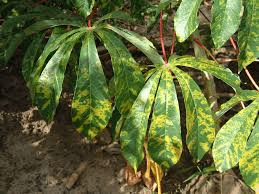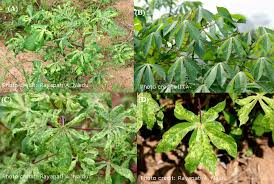Cassava, Manihot esculenta, is a perennial shrub in the family Euphorbiaceae grown primarily for its storage roots which are eaten as a vegetable. The cassava plant is a woody plant with erect stems and spirally arranged simple lobed leaves with petioles (leaf stems) up to 30 cm in length. The plant produces petal-less flowers on a raceme.
The edible roots of the plant are usually cylindrical and tapered and are white, brown or reddish in color. Cassava plants can reach 4 m in height and is usually harvested 9-12 months after planting. Cassava may also be referred to as Brazilian arrowroot, manioc, yuca or tapioca and the origins of the plant are unknown.
Cassava is one of the most important staple food crops in Africa. Three continents, Africa, Asia and Latin America produce large amounts of cassava roots. Over 500 million people in the tropical world particularly Africa depend on cassava as one of their major staple foods. In Asia and Latin America, productions are largely used as raw materials for industries, as animal feed or for export markets. In Africa, the bulk of production is depended on as food by humans.
Cassava is one of the most significant food security crops in some parts of sub-saharan Africa and has proved to be the most dependable crop in a number of countries as the last line of defence against famine. In the last decade, cassava is cultivated not just for human consumption in sub-saharan Africa but also to provide raw materials for emerging industries that depend on products from the roots, particularly starch.
The ability of cassava to thrive or do well on poor soils gives it an advantage over yam and the other root and tubers, grains or legumes in Africa. For many years to come cassava will continue to be an important source of carbohydrate to millions of people, particularly the rural and urban poor in Africa.
Cassava, therefore, has to be managed more effectively than it is currently experiencing to increase its yield per unit area to ensure that more than enough roots in particular are produced to satisfy domestic, industrial and food security requirements at all times.
Among the factors that affect cassava production, diseases and pests still remain the major constraints that can bring Africa’s cassava production to a halt. The recent East African Cassava Mosaic pandemic and the food shortages that resulted from it adds value to the above statement.
African cassava mosaic disease is still widespread and causes severe yield losses in production systems that depend on susceptible cultivars. Cassava bacterial blight, anthracnose, bud necrosis, leaf spots and root rot diseases affect yields of cassava in almost all producing countries in Africa.
Read Also: How to Start a Cassava Farming and Processing Business
Significant Effects of Cassava Diseases and Pests

1) Diseases cause low yields of edible roots.
2) Low yields due to diseases affect incomes of farmers.
3) Food security is reduced by diseases.
4) Severe outbreaks of diseases such as cassava bacterial blight can result in famine (in whole communities or countries).
5) Cassava diseases that affect stems can lead to loss or shortages in the supply of planting materials.
6) Loss of leaves through diseases can affect the availability of leafy vegetables.
7) Loss of leaves and poor yield of storage roots can affect livestock production in communities that use cassava as animal feed.
Pests and diseases are the major reasons why many agribusinesses fail. They increase the loss of cassava which should have contributed to your overall profit.
The major pests and diseases of
cassava are:
1. Thrips and Mites
Can be controlled using a recommended miticide and Insect Growth Regulators. These pests are prevalent during dry periods and decreases as rainfall increases.
2. African cassava mosaic virus
The African cassava mosaic virus causes the leaves of the cassava plant to wither. When such withering occurs, it limits the growth of the root. The best control measure is to plant resistant varieties.
3. Cassava mealybug
This causes a reduction in
inter-node length of cassava stem. This pest can cause up to 80% crop
loss, which is extremely detrimental to the production of subsistence
farmers.
4. Insects
Some insects affect the plant directly. For instance, locusts feed on cassava leaves. Ants and termites eat up cassava stems as soon as they are planted, or later in the season; therefore destroying whole plants.
Others affect the plant indirectly by the transferring virus into the plant. Use recommended insecticides and Insect Growth Regulators to control insects.
Read Also: How to Process Cassava Chips for Animal Feed
5. Herbivorous Animals
Grass-cutters, pigs, goats, and
sheep frequently expose and eat up roots in the soil. The damage to
the roots can provide an entry for the microorganisms that cause
roots to rot.
To prevent this, Keep the farm and
its surroundings weed free. Use traps and poisoned grains to kill
them or wire mesh fencing to prevent them from entering your field.
You have come a long way in reading this post to this point. Just before you start reading about another agribusiness, please take a minute to share this post using the share button.
If you have a question or contribution, please submit them in the comment section. I will review it and publish immediately.
Read Also: 12 Management Tips for better Poultry Performance Potential
Frequently Asked Questions
We will update this section soon.


